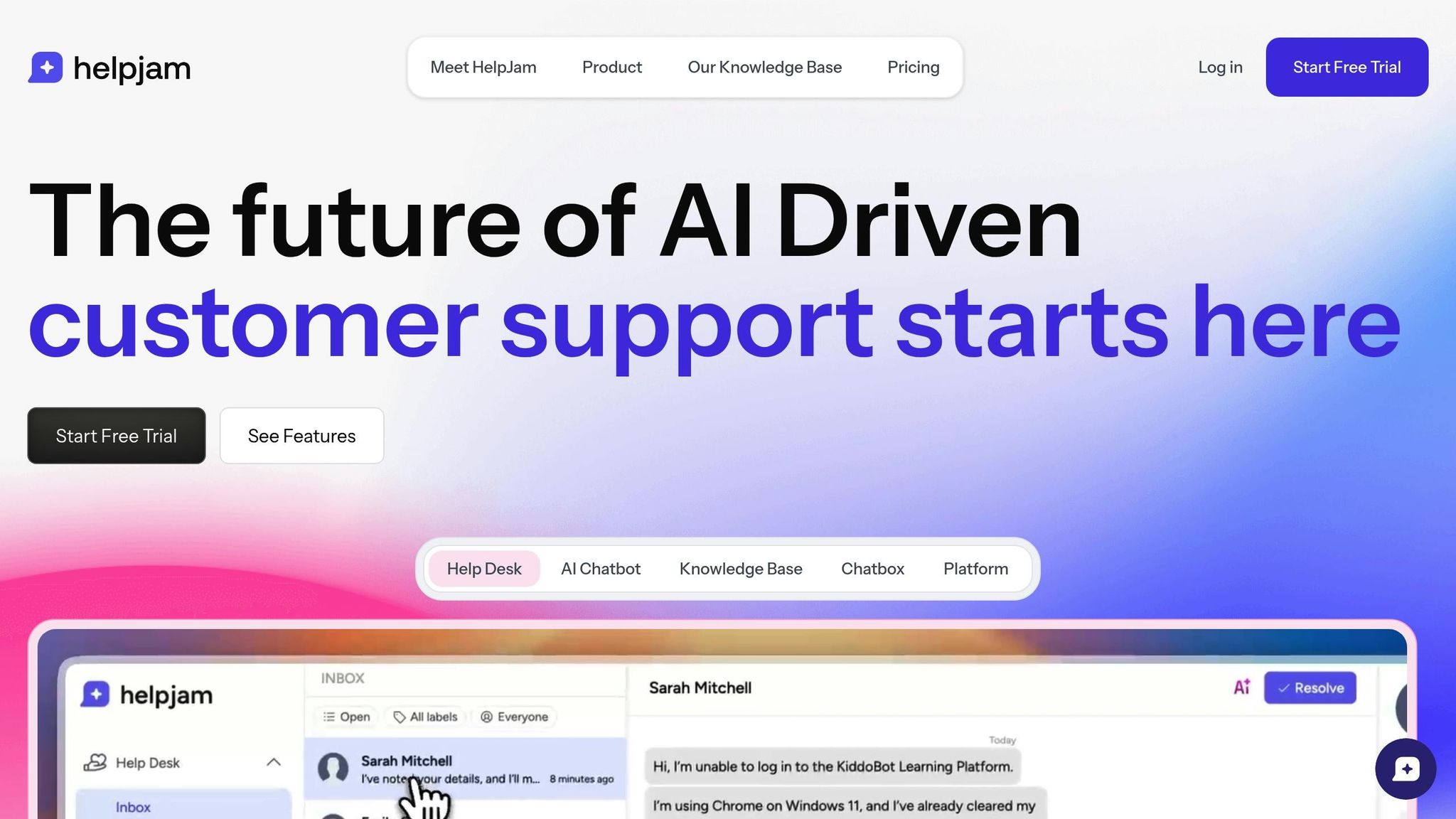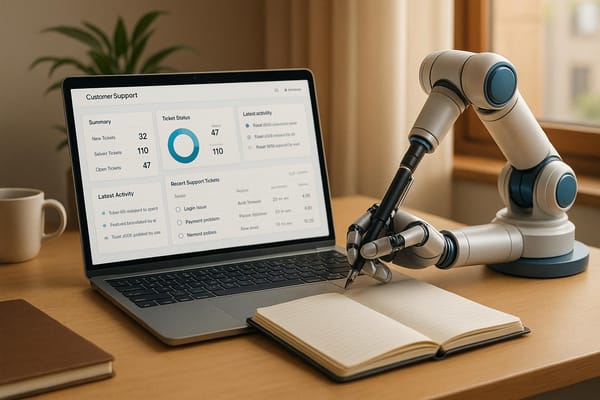Building a Customer-Centric Service Culture for Growing Teams
Learn how to build a scalable customer-centric service culture that enhances employee engagement and boosts customer loyalty.

Companies that prioritize customer experience grow revenue 4%-8% faster than their competitors. But as teams expand, maintaining quality service becomes challenging. Here's how to build a customer-first culture that scales:
- Core Principles: Clear vision, empowered employees, and alignment across teams.
- Key Benefits: Higher revenue, reduced costs, and improved loyalty.
- Big Challenges: Maintaining service quality, managing response times, and balancing automation with a human touch.
-
Actionable Steps:
- Use the right tools (like AI and CRMs).
- Build a centralized knowledge system.
- Connect support efforts to business outcomes.
- Train teams regularly.
Quick Tip: Automation can improve efficiency by 94%, but keeping the personal touch is crucial for loyalty.
Whether you're a small team or scaling fast, these strategies ensure customer satisfaction stays at the heart of your growth.
What Makes a Customer-Focused Service Culture
Core Elements of Customer Service Culture
Creating a customer-focused service culture means more than just having good customer service policies. It's about making customers the focal point of every decision and interaction within the business. Companies that prioritize this approach see real results - research shows they grow revenue 4% to 8% faster than their competitors.
This type of culture is built on three key pillars:
- A clear customer service vision that drives all company actions.
- Empowered employees who can make decisions that benefit customers.
- Company-wide alignment around customer success initiatives.
These principles become even more important as organizations grow and teams expand.
Impact on Growing Teams
As teams scale, the benefits of a customer-focused culture become evident:
| Impact Area | Measurable Result |
|---|---|
| Revenue Growth | 84% of organizations saw increased revenue |
| Cost Efficiency | 79% reported noticeable cost savings |
| Customer Loyalty | 25% boost in customer loyalty |
| Customer Confidence | 20% rise in customer trust |
For expanding teams, this approach ensures growth while maintaining high service standards.
Main Features of Customer-First Companies
Companies that prioritize customers excel by embedding service excellence into their operations. Here’s how they do it:
- Centralized customer insights to make informed, data-driven decisions.
- Cross-department collaboration to ensure customer service is integrated throughout the organization.
- Engaged employees who are motivated to enhance customer satisfaction.
- Ongoing training to ensure consistent service quality.
- Performance metrics directly tied to business goals.
These strategies allow businesses to scale effectively while keeping service quality intact, paving the way for sustainable success.
Growth Challenges in Customer Service
A staggering 86% of customers are willing to pay more for better experiences. Yet, as customer service teams grow, maintaining consistent quality across all touchpoints becomes a real challenge. Understanding these hurdles is essential to building a scalable service culture.
Keeping Service Quality Steady
When teams expand quickly, training new agents often leads to inconsistent service quality, which can hurt customer satisfaction. Here’s how some common challenges impact service - and how to tackle them:
| Challenge Area | Impact on Service | Solution Strategy |
|---|---|---|
| Agent Knowledge | Inconsistent responses | Standardized training programs |
| Quality Control | Varying service levels | Clear quality metrics and monitoring |
| Team Coordination | Communication gaps | Centralized knowledge management |
| Process Adherence | Inconsistent workflows | Documented standard procedures |
But quality isn’t the only issue. Response time is another pressing concern.
Managing Response Time Issues
Nearly half (46%) of customers expect a response within four hours. As inquiries pile up, meeting this expectation becomes tougher, leading to rushed responses that compromise quality.
Teams often face added pressure from:
- Sudden spikes in customer inquiries
- Handling multiple complex issues at once
- A shortage of experienced staff
- Supporting customers across various time zones
Automation vs. Personal Touch
Balancing automation with human interaction is a game-changer. Automation tools can deliver impressive results:
- 94% boost in team productivity with AI integration
- Cost savings of up to 40% through automated processes
- 20% improvement in customer satisfaction scores
"Remember, it's not about replacing humans with machines but rather enhancing the customer experience by leveraging automation where it makes sense while preserving the human touch where it matters most."
To tackle these challenges, a hybrid support model is key. Automation can handle routine tasks efficiently, freeing up human agents to focus on complex, empathy-driven interactions. Striking this balance ensures speed without losing the personal engagement that keeps customers loyal.
5 Steps to Build Customer-First Service
Choose the Right Support Tools
As teams grow, having the right support tools becomes essential. CRM usage jumped by 74% in 2023, showing how critical it is to adopt platforms that integrate seamlessly with your systems, are easy to use, and can grow with your business. For example, when Samsung revamped its support site in 2022 with AI analytics, they saw a 19% boost in customer engagement. This highlights how the right tools can elevate service quality.
Use AI to Speed Up Service
Once you've selected the right platform, AI can take your service to the next level. By 2024, AI is expected to handle 30% of customer support interactions. In practice, this has already led to impressive results, like reducing response times by 95%, automating 30% of queries, and resolving 500 issues without human involvement.
Build a Knowledge-Sharing System
Centralizing information helps both your team and customers find answers faster. Here’s how you can structure an effective knowledge base:
| Component | Purpose | Impact |
|---|---|---|
| Internal Wiki | Team training | Ensures consistent service delivery |
| Public Knowledge Base | Self-service options | 60% of customers prefer automated solutions |
| AI-Powered Search | Quick access to info | Speeds up resolution times |
This approach empowers your team and reduces dependency on live support.
Connect Support to Business Results
While 80% of companies think they provide excellent customer experiences, only 8% of customers agree. Bridging this gap means:
- Systematically gathering customer feedback
- Sharing insights with other departments
- Using support data to improve products
- Setting customer-focused goals to measure success
Tying support efforts to business outcomes ensures a service approach that truly prioritizes customers.
Train Teams Regularly
Setting clear goals can increase employee engagement nearly threefold. Regular training - such as skill assessments, peer mentoring, AI tool workshops, and feedback sessions - keeps teams sharp. Remember, satisfied employees are 20% more productive. Investing in both technical training and emotional intelligence helps teams deliver better customer experiences.
HelpJam Features for Customer Service

HelpJam focuses on delivering tools that enhance efficiency while maintaining a personal touch, even as customer service teams expand.
AI Support Tools
HelpJam's AI platform is easy to set up - just provide a sitemap link, and it will learn from your knowledge base, PDFs, and web pages. It keeps itself updated with your latest content automatically. The AI copilot helps support teams by summarizing conversations, suggesting replies, and proofreading, allowing agents to spend more time connecting with customers.
Beyond assisting agents, HelpJam also improves team communication with effective management tools.
Team Management Tools
The shared inbox system simplifies collaboration for growing teams. Agents can smoothly transfer conversations, add private notes, and handle customer inquiries as a cohesive unit.
HelpJam's AI-powered text editor offers:
- Effortless documentation creation and formatting
- Support for images and videos
- Real-time team collaboration
- AI-enhanced response suggestions
These tools not only enhance teamwork but also ensure smooth communication across languages and budgets.
Language Support and Pricing
HelpJam supports multiple languages in all its plans, featuring a side-by-side translation editor for accuracy.
| Plan | Monthly Cost | Key Features |
|---|---|---|
| Starter | $49 | Essential tools, up to 5 team members |
| Growth | $99 | Advanced AI tools, up to 10 team members |
| Business | $199 | Unlimited team members, dedicated support |
Performance Tracking
HelpJam's analytics dashboard offers real-time insights into your support operations. Teams can track metrics like conversation volume, resolution times, knowledge base effectiveness, search trends, and AI chatbot performance. These analytics highlight areas needing attention, enabling teams to make data-driven improvements. The platform also identifies trending topics and frequent customer questions, helping teams create relevant content and refine their support strategies.
Conclusion
Building a service culture that puts customers first is key for growing teams. Research shows that companies focusing on customer needs can see up to 60% higher profits, along with increased revenue and cost savings. Plus, customers who feel emotionally connected to a brand are worth 306% more over their lifetime.
As we’ve discussed, scaling while keeping quality intact is no easy feat. HelpJam’s AI-powered tools provide the personalization and efficiency needed to meet this challenge - especially important when 60% of customers say their service expectations have risen in the past year. Tools like HelpJam offer practical solutions to help teams stay ahead.
Apple CEO Tim Cook sums it up perfectly:
"Our whole role in life is to give you something you didn't know you wanted. And then once you get it, you can't imagine your life without it."
HelpJam’s AI chatbot, knowledge base, and collaboration features empower teams to deliver consistent, high-quality service while staying efficient. Success in customer service comes down to fostering a culture where every team member prioritizes creating great customer experiences. With the right tools and approach, growing teams can form strong, lasting relationships that fuel long-term business success.





